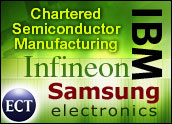
Semiconductors sales grew by more than 13 percent in the first quarter, outpacing forecasts thanks to demand for chips installed in smartphones and other portable devices, a trade group said today.
The Semiconductor Industry Association (SIA) said sales for the first three months were US$55.3 billion, up 13.2 percent from the $48.9 billion in worldwide sales in the same time frame last year.
The growth comes as a surprise. Forecasts were for lower growth rates for 2005, and the first quarter is typically a low-volume one during which computer and device makers focus on working down inventory built up during the fourth quarter.
Good Sign
“The first quarter is historically a relatively weak one for the microchip industry,” said SIA President George Scalise. “The unexpected strength of semiconductor sales … is a good sign for the industry.”
Sales were up from the fourth quarter by 0.4 percent. Sales for March were up 2.2 percent from February, to $18.4 billion.
The SIA said consumer electronics, rather than corporate demand, was what drove the increases. “Consumer spending on electronics was stronger than historical patterns for the first quarter despite reports of declining consumer confidence,” Scalise said.
Scalise said the current second quarter is likely to see sales flat to slightly higher compared to a year ago. The industry group said it would release an updated forecast for the full year next month. Its original outlook had called for flat sales, which Scalise acknowledged “now appears to have been overly cautious.”
Slowdown Coming?
In fact, forecasts vary widely, with several firms calling for a supply glut to be worked through in the second and third quarters, paving the way for stronger growth again in the last part of 2005 and beyond.
Advanced Forecasting said the industry remains “relatively robust,” despite some softness in revenue caused by pricing pressure. Still, the firm said the current growth “will not be long-lasting.”
Some individual chip makers have battled the perception that demand is slackening, with companies such as Intel, Advanced Micro Devices and Samsung Electronics all adjusting their forecasts.
Standard & Poor’s said in a report released yesterday that major chipmakers such as Intel face a difficult year as they try to match up to strong growth patterns from the year-ago time period.
The prospect of cooling sales means that a premium will be placed on execution of strategies, which in the current climate means a heavy emphasis on supply of 64-bit chips to the PC market, while pushing to expand into the consumer market at every opportunity, Mercury Research analyst Dean McCarron told the E-Commerce Times.
“Chip makers know they can’t count on organic growth in the long term,” he said. “At some point, you get back into a battle for market share,” where Intel has “the upper hand.”
Peaks and Valleys
The semiconductor market has traditionally been highly cyclical, with steep peaks in demand and periods of lighter activity based on the demand for computers and other devices from businesses and consumers. The industry is also highly sensitive to overall market conditions.
However, some analysts had been calling for an additional “correction” in the semiconductor market, as product makers decreased the number they bought after overestimating how many chips they’d need to keep up with demand.
Late last year, research firm IDC predicted negative growth for the chip industry in 2005, with sales shrinking 2 percent when compared to what had been a very strong 2004. However, even that report called for a strong long-term outlook, with double-digit annual growth rates over a five year period.
More recently, the firm noted the surge in semiconductors for cell phones and other consumer devices was lifting the overall industry. However, the shift to a market driven by consumer growth also poses challenges to the chip industry, IDC senior research analyst IdaRose Sylvester said.
“The consumer semiconductor market is one of the fastest growing and most challenging segments in the industry,” Sylvester said. “Only the most strategically focused semiconductor vendors are going to benefit substantially from this growth.”






















































Social Media
See all Social Media